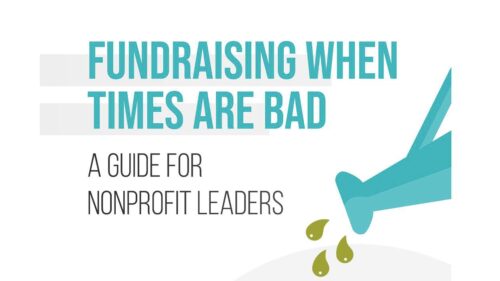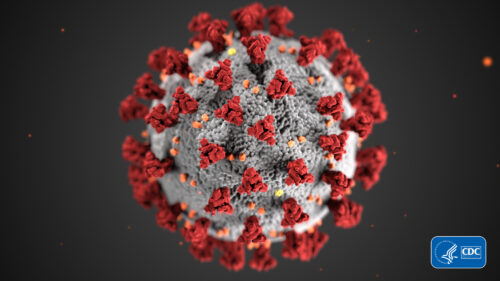The sudden economic downturn has everyone wondering how the nonprofit sector will be affected. Historical trends can help us predict how your charitable revenue may be affected.
Among the many questions keeping nonprofit leaders up at night is this important one: in light of the coronavirus crisis, what kind of dip can I expect in charitable giving to my organization?
One of the ways to come up with a reasonably decent answer to that question is to look at the big picture.
In America, charitable giving is clearly and consistently connected to gross domestic product, or GDP. Total giving has hovered at 2% of GDP since the mid-twentieth century. This relationship held even in the Great Recession of 2007–9, when it dipped only to 1.9% in the years following (2009–11).
We might ask, then, in light of everything we currently know—or perhaps better, think we know—about COVID-19 and its effects on society and our economy thus far: how much of a decline in GDP should we expect in 2020?
Fortunately, the Wall Street Journal asked this question, among others, in its monthly survey of economists a few days ago. The economists’ aggregate expectation was that GDP will decrease by 4.9% in 2020. That’s not good; GDP dropped by 4.3% over the two years of the Great Recession.
It’s worth keeping in mind that, as one of my colleagues says, macroeconomic forecasting is about as reliable as astrology. Still, let’s pretend, for now, that the considered opinion of economists is meaningful. For nonprofits, would a 5% GDP decline be catastrophic?
Perhaps not. Let’s do the math. U.S. GDP in 2019 was $21.44 trillion. Assuming charitable giving was, as usual, 2% of that total (we don’t have the real numbers yet), then total giving last year was roughly $450 billion.
Run the numbers, and we find that if GDP declines by 5% this year, and if charitable giving dips to 1.9% of GDP as it did in the aftermath of the Great Recession, then we would be looking at a $43 billion drop in giving—in other words, a decrease of 10%.
In summary, a drop of 5% in GDP in 2020 should equal a drop of 10% in charitable giving. For most nonprofits, that would be a survivable, if painful, decrease.
Of course, the extent to which different nonprofits will feel this overall reduction in charitable giving will vary widely. There are five factors I can think of as being major differentiators:
- Mission. The more a nonprofit’s programs provide direct aid to those hurt by this crisis, the less its charitable-giving revenue should suffer. Human-services groups tend to do comparatively well when the need, or at least the perceived need, for their services becomes more acute. It would seem to be the case, then, that the more successfully a nonprofit can persuade donors that its work is clearly tied to ameliorating or solving problems caused by the novel coronavirus, the lower it can expect its drop in giving to be.
- Region. Nonprofits in areas hit harder economically can expect larger decreases in charitable-giving revenue—with the important caveat that human-services nonprofits in these areas might see very little, if any, drop in giving if the perceived need for their services is commensurately greater.
- Characteristic giving modalities. If an organization’s giving revenue tends to come through events or mission trips or anything that requires in-person get-togethers, that group is going to have to work extra hard, and be creative, in recapturing funds. Groups that do a lot of asks through in-person meetings will have to pivot, too. Groups that raise most funds through the mail or digitally will at least not have to alter their basic fundraising methodology.
- Characteristic donor mix. Having a diverse donor base is generally a very good thing, just like it is usually good to be invested in a diversified mix of mutual funds. But sometimes it’s advantageous to have large holdings in healthcare or tech, and right now the same is true for nonprofits whose major funders are private foundations or governmental entities. We can expect giving from those sources to remain at or near pre-crisis levels this year, at least; conversely, individual and corporate donors will generally cut back more.
- Fundraising effectiveness. The truth is that most nonprofits are underinvested in development. Even in good financial times, this mistake keeps them from realizing their potential. In a tough economy, nonprofits with mediocre to nonexistent fundraising systems and plans are likely to be hit especially hard, while those which are good to excellent on the fundraising fundamentals are likely to weather the storm in comparatively good shape.
Here, then, is a way forward for nonprofit leaders. Take 10% as your baseline for expected decrease in charitable-giving revenue—and check that number every month as things play out. Assess where your organization stands with respect to the five differentiating variables of mission, region, giving modalities, donor mix, and fundraising effectiveness, and then adjust from 10% accordingly. You may end up expecting only a 5% decrease, a 20% decrease, or no decrease at all. But in any case, you will have a better idea of what to expect, and you can plan accordingly.
If I can be a resource as you work to assess your fundraising situation and plan for the future, please feel free to email me at jbeer@americanphilanthropic.com.
For the next several weeks, Philanthropy Daily will be a resource for fundraisers in the midst of the COVID-19 pandemic. Check back daily for new articles addressing news about coronavirus and philanthropy and providing strategic and practical recommendations for weathering this storm as a fundraiser.
And please join us on Thursday afternoons at 2:00 Eastern time for a webinar on “Fundraising During Uncertain Times.” American Philanthropic leadership and Philanthropy Daily authors are hosting this weekly webinar to discuss the impact of the pandemic on fundraising and to answer your questions. Sign up here.






